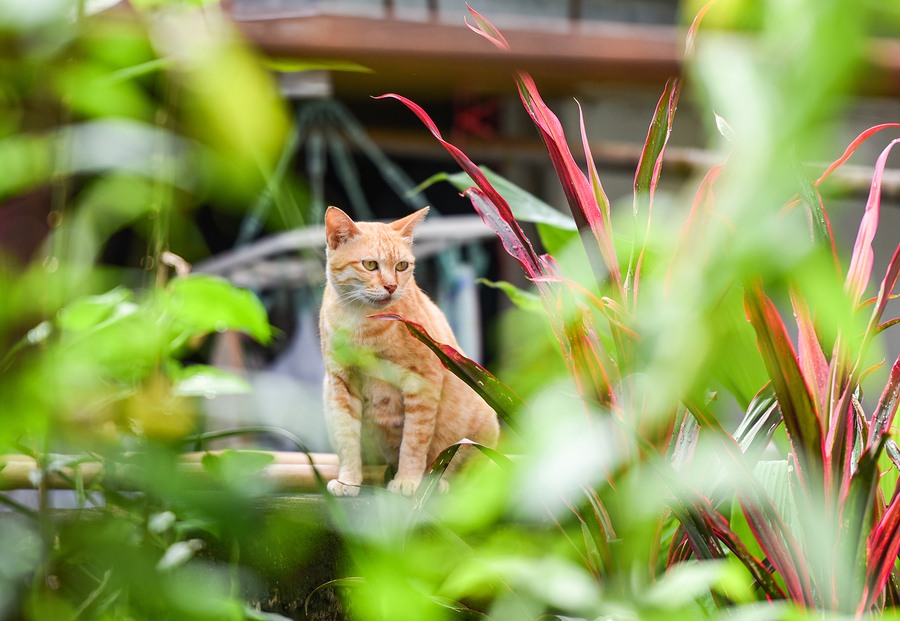Yard cat repellents — what does and doesn’t work? The fact of the matter is, cats are unpredictable. The all-too-familiar felis catus or domestic cat, shares many behaviors with its wild cousins. Cats are a product of domesticated wildcats (and their big cousins). The largest being panthera tigris or tiger, panthera leo or lion, the second, panthera onca or jaguar, the third and panthera pardus or leopard, being the smallest of the big four. All share many of the same traits, which makes keeping cats out of your garden or landscape a challenge. But, this doesn’t mean you can’t keep felines from wreaking havoc. You can use certain methods to create cat repellents for your property.
Why Cats are Attracted to Yards
Cats are known as curious creatures. And, these four-legged furry felines certainly live up to their reputation. By their very nature, cats love to explore. Although cats are said to have nine lives, your landscaping might not enjoy the same durability. Cats are attracted to gardens and landscape features for a variety of reasons. One such attraction is the presence of prey items, such as rodents. Squirrels, mice and more prove too tempting to ignore. Another attraction are trees. Even the most messy trees in a yard are great for climbing.
Cats can benefit homes by keeping away rodents and insects, but many people do not like cats in their yard. If you want to keep cats out of your yard, there are many humane ways that do not harm them or involve removing them from the neighborhood. Keep in mind that what might work for one cat, might not work for another, so be willing to try more than one solution. And, if you know the cat’s owner or caretaker, ask them for advice and assistance in keeping their cats close to home. —SPCA
Flowering plants are likewise a big attraction. Some cats like to nibble on certain plants. And, if this isn’t enough, koi fish in a pond are a prime motivator. Then, there’s the presence of other cats. Unlike lions, which live in prides, most large cats (jaguars, leopards, cougars and more) live solitary lives. So, when a cat picks up a scent of another feline, it can lead directly to your yard. To keep neighborhood and even feral cats at bay, you’ll have to use different techniques.
Effective Yard Cat Repellents for Your Landscape
While it’s difficult enough to make your dog and yard coexist, it’s not much easier to cat-proof your garden, landscaping or outdoor space. To be the most effective, you’ll have to employ a variety of methods. After all, cats are well-known to be independent and individual personalities. That means what works to keep one cat away might not work with another. Here are a few yard cat repellents you can try out:
- Chicken wire galore. Before you start conjuring ugly images in your mind, we’re not talking about installing chicken wire as a barrier fence (though that is a good cat repellent option). Place chicken wire right on top of the soil before planting. Cats do not relish walking on this tactile surface, making it an effective, preventative measure. Best of all, you can cut small holes using wire cutters to plant flowers, vegetables and more.
- Motion-detecting sprinklers. Aside from jaguars, most cats do not like water. This is probably due to the fact their fur isn’t water-resistant. So, cats avoid getting wet because they’ll feel waterlogged. Use this to your advantage by installing motion-detecting sprinklers. The trick here is to find the sweet spots where the devices are the most effective. When honed, trespassing felines will receive a short burst of water.
- Ultrasonic devices. Sticking with technology, you can also use ultrasonic devices. If you’ve ever had a kitten or cat in your household, you know startling noises make felines jump and scatter quickly away. Best of all, you won’t hear any noise because the range isn’t audible to humans.
- Non-toxic scents. Speaking of the difference between animals and humans, scent is another weapon in your arsenal against cat intruders. Humans have approximately 5 million scent receptors, while dogs have between 100 and 300 million. Cats have about 80 million scent receptors. So, non-toxic scents, such as cayenne pepper, black pepper, coffee grounds, and orange peels, all work well.
- Catnip plants. Another alternative is to create an attractive, dedicated space. By growing catnip and catmint (nepeta cataria, which is a hardy mint family perennial herb), you’ll create a temptation diversion. Simply grow this in one area of your yard and garden in another space. Catnip and catmint serve as a good deterrent.
If it’s time to update your landscaping, don’t hesitate to contact us. We are a full-service, professional landscape design company and serve all of Sarasota, including near Bayfront Drive, around Rolling Green Golf Club, along Longboat Club Road, and elsewhere.



